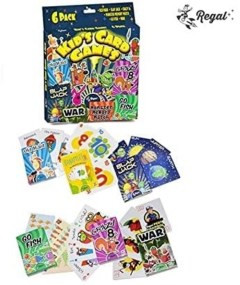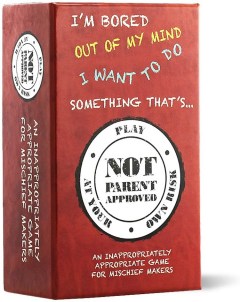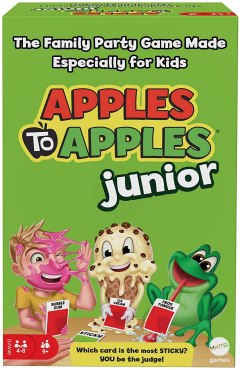BestReviews is reader-supported and may earn an affiliate commission. Details

A fun and engaging game with a simple concept that all ages can understand.
A fun and engaging game with a simple concept that all ages can understand.
Comes with markers and an erasable board. Great for family game nights and parties. Amusing and entertaining.
A number of cards include pop culture references that not everyone will understand.

A great pack that features tons of easy-to-learn card games.
A great pack that features tons of easy-to-learn card games.
Comes with 6 card games that are engaging and fun for younger and older kids. Cards are larger than normal, making them easy to hold. Helps teach kids colors, numbers, and light strategy concepts.
Some users felt that the images on the cards weren't as good looking as they would like.

A fun game with humor that older kids will enjoy.
A fun game with humor that older kids will enjoy.
Just edgy enough for kids to enjoy it, but still fun for Tweens. Great for people who love potty humor. Engaging. Gets people's hands off of their devices for a while for some face time. Rules are very easy to pick up and learn.
A good game for older kids to play together, but it might be a bit boring for adults.

A great game that creates fun memories for the whole family.
A great game that creates fun memories for the whole family.
Allows kids to come up with creative ideas that make the entire family laugh. Comes with 504 different cards, allowing for hours of enjoyment. Helps build a larger vocabulary for younger kids. Comes with good instructions.
The cards are a little flimsy, leading to easy ripping or folding.

A classic card game with an active twist that will keep the whole family engaged.
A classic card game with an active twist that will keep the whole family engaged.
A simple card game based on matching numbers and colors. This version of the classic game has been updated with a machine that shoots cards at random. It also has "make your own" wild cards. Rated for age 7+, but younger kids can play this game with a little help.
Inserting cards into the dispenser can be tricky. The attack twist can also make the game go on a long time.

We recommend these products based on an intensive research process that's designed to cut through the noise and find the top products in this space. Guided by experts, we spend hours looking into the factors that matter, to bring you these selections.

Playing cards have been around for over a thousand years. Clearly, they've stood the test of time. Over the past millennium, however, card games have evolved, especially card games for kids. Today, there are thousands of card games available. How do you know which ones are the best?
The right card game for a child is one that captures their interest. The cards may be brightly colored, but the theme should be something the child enjoys. The rules shouldn't be overly complicated. Often, the best card games for kids put every player on a somewhat level playing field by involving a little luck as well as skill.
If you are searching for information about card games for kids, you have come to the right place. In this guide, we discuss the key considerations to keep in mind when shopping as well as the benefits of giving your child a card game to play.

Age appropriateness is critical when choosing a card game for a child. For example, small playing pieces could pose a choking hazard for a very young child. Additionally, a card game designed for “ages three and up” likely would not entertain a preteen. Lastly, there are a few card games that are simply inappropriate for children. Following the age range listed on the box is recommended.
Some card games are designed to be thrilling for just two players. Other card games can quickly turn boring if there are not at least four people engaged in the game. Try to match the card game to the number of players who will most often be playing. For example, if you have four family members, a card game designed for four players may be ideal.
Not all card games need multiple players. Teaching your child to play solitaire can help them learn to enjoy alone time.
Card games that can be played multiple times without becoming predictable are ideal for children. Games that feature grouping or matching or have an outcome that is dependent on how the cards are shuffled tend to have a longer active life than games that feature bits of trivia or finite options.
The cure for games that become predictable is booster packs. If you can purchase additional decks that expand how the original game is played, it can infuse new life into an old game.
Do you want to play a game where victory depends solely on luck? Or, do you prefer one that requires strategy? While the choice is yours (actually your child's), usually, a game that involves a combination of strategy and luck is the most fun.
Educational focus is important for kids who need help in certain areas. Some card games rely on number and color recognition while others require knowing mathematical knowledge or memory skills. Choose a game that helps develop your child in areas where they need it the most.
If your child has a favorite something, look for a card game designed around that theme. It could be race cars, princesses, video game characters, animals, or something else.
Games with an overwhelming number of rules can be more tedious than fun. The ideal card game should be fairly easy to play on the first attempt yet challenging enough that your child doesn't lose interest.
While the most important part of a card game is the cards, some games incorporate other elements, such as a game board, playing pieces, action figures, or electronic equipment. If you want an experience that goes beyond the cards, look for a game that has one or more of these extras.

When you purchase a card game, you usually get everything you need to play the game at the time of purchase. However, there are a few accessories that you might want to consider to enhance the experience.
Card holder: Gamewright Little Hands Playing Card Holder
Sometimes, little hands have a hard time holding multiple cards. This device is designed to help kids ages three and up hold their cards.
Travel case: Luck Lab Single Deck Leather Playing Card Case
If you love to play card games, this single-deck travel case with felt-lining and magnetic closure will let you bring the fun with you wherever you go. And, it will let you do so in style.
Card tray: Brybelly 6-Deck Rotating-Revolving Card Tray
How many times has your draw pile spilled into your discard pile and created havoc during gameplay? This handy card tray holds two stacks of narrow or wide cards and rotates to provide convenient access for all players.
Card shuffler: Yuanhe Casino 2-Deck Automatic Card Shuffler
Even if the kids don't need help shuffling, having a card shuffler can add a little fun and excitement to their game. This model shuffles up to two decks of standard-size cards in seconds. It requires four AA batteries (not included).
Inexpensive: The most affordable card games for kids cost less than $10. These are basic games such as Go Fish or Crazy 8s, which require only one deck of cards to play.
Mid-range: For $10 to $20, you will find card games that employ multiple decks or use other accessories, such as a game board or small electronic device. You may even find bundles that include several games in one package.
High-end: Moving above $20, you can find themed games in which the cards may also be collectibles. In this price range, the games will most likely be for older kids and have more complicated rules.
For the very young, choose card games that are simple to play so the child can easily grasp the concept and devise their own strategy to win.
A child learns skills when playing card games that can lead to development in other areas. Here are some of the benefits of playing card games.

A. Kids like to have fun, and they are impressionable. The easiest way to get them interested in an activity like a card game is for parents to play along and have fun. When your child sees you doing something you enjoy, they will be more open to trying it themselves.
A. Winning builds confidence that can transfer to other areas in life. If you let your child win, they will enjoy the game more. On the other hand, losing can help a child learn to deal with disappointment. It also shows a child that winning is something that is earned. Many parents decide that the best approach is a mixture of these two tactics.
A. One strategy is to not make a big deal of losing yourself. Another: when your child is young, don't allow winning to become the main focus. Having fun and playing the game is what is important.
When your child loses, look for the lessons to be learned. For example, how could they have played better? Also, teach them to sincerely congratulate the winner. As your child gets older, knowing what it feels like to lose can give them compassion in other life situations.
Get emails you’ll love.
Learn about the products you’re wondering if you should buy and get advice on using your latest purchases.
